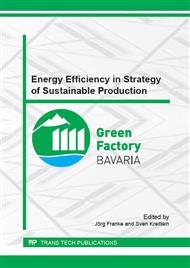p.171
p.180
p.187
p.196
p.205
p.213
p.223
p.231
p.241
Measurement of the Resource Consumption of a Selective Laser Melting Process
Abstract:
One important purchasing criterion for end customers is the resource consumption of products, which manufacturers aim to reduce through sustainable product designs and optimization of production processes. In order to quantify the resource consumption, in this study the demand of raw materials and operating materials of the selective laser melting process was quantified according to the methodology developed within the initiative Cooperative Effort on Process Emissions in Manufacturing (CO2PE!). The selective laser melting process was selected due to two reasons. First, the process enables lightweight constructions, which offers the potential to reduce the resource consumption during the product use phase. Second, few studies have been published about this process so far which also measure the demand of compressed air and shielding gas apart from the electric energy demand. It was found that the resource demand for the manufactured 0.5 cm3 cuboid part amounted to 3.6 kWh electric energy, 0.81 m3 compressed air and 0.31 m3 Argon. This corresponds to an energy demand of nearly 1000 kWh/kg, though such key performance indicators alone are not very representative for the selective laser melting process, as described below.
Info:
Periodical:
Pages:
205-212
Citation:
Online since:
November 2015
Price:
Сopyright:
© 2015 Trans Tech Publications Ltd. All Rights Reserved
Share:
Citation:


